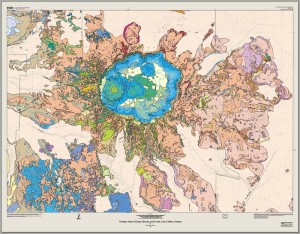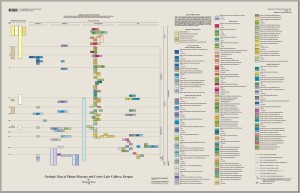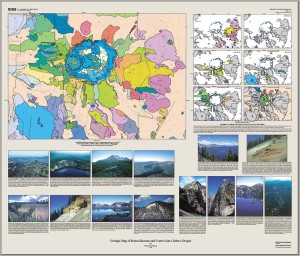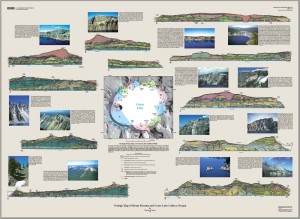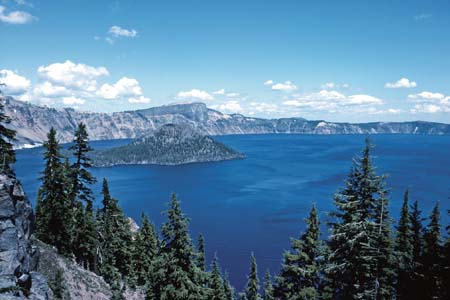Review: Geologic Map of Mount Mazama and Crater Lake Caldera, Oregon by Charles R. Bacon
Crater Lake Institute
July 7, 2009
by ROD CRANSON
Great source of geological material for teaching
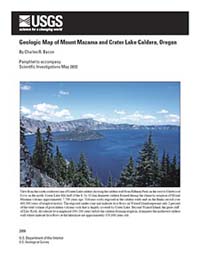 Crater Lake in south central Oregon fills one of the most spectacular calderas in the world. It is an 8-by-10-km basin more than a kilometer deep. USGS geologist Charlie Bacon has completed a 30 year study of this classic geologic area including field research, mapping, collecting, and dating the volcanic material in Crater Lake National Park , Oregon . Mount Mazama and the resulting Crater Lake Caldera is arguably the most thoroughly studied volcanic area in the United States , if not the world. Bacon’s work is now available in 4 beautiful colored geologic sheets (3 maps and a map unit correlation chart) plus a descriptive pamphlet.
Crater Lake in south central Oregon fills one of the most spectacular calderas in the world. It is an 8-by-10-km basin more than a kilometer deep. USGS geologist Charlie Bacon has completed a 30 year study of this classic geologic area including field research, mapping, collecting, and dating the volcanic material in Crater Lake National Park , Oregon . Mount Mazama and the resulting Crater Lake Caldera is arguably the most thoroughly studied volcanic area in the United States , if not the world. Bacon’s work is now available in 4 beautiful colored geologic sheets (3 maps and a map unit correlation chart) plus a descriptive pamphlet.
Review of Geologic Map of Mount Mazama and Crater Lake Caldera, Oregon, 2008 by Charles R. Bacon; U.S. Geological Survey of the U.S. Department of the Interior; Scientific Investigations Map 2832 with descriptive pamphlet (45 pgs), ISBN 978-1-4113-1925-7, 4 sheets plus CD Database for the Geologic Maps; $19.00.
Bacon’s goal was to document the spatial distribution, volume, composition of eruptive products through time, evaluate potential natural hazards, and geothermal resources. Sheet 1 shows all the mapped surface rock units found in the park. In addition to the volcanic materials that compose the flanks of Mount Mazama and the climactic eruption ejecta, this map details the geology and history of the caldera floor in amazing detail. This caldera floor information adds significant details to the geologic history of the area that was not available before.
Sheet 2 details the igneous and sedimentary rocks that occur at Crater Lake National Park. All rock types are described in color with designation keys that correlate with the other three associated sheets. Symbols for dikes, faults, glacial features, volcanic vents, and dated sample locations are also indicated.
Sheet 3 is a combination of the larger map featured on sheet 1 and a series of bedrock geologic maps that illustrate and interpret the volcanic history of the area with brief interpretations. All are in color correlating with the rocks described on sheet 2. It also includes a set colored images of selected geologic features with brief descriptions of the geology shown.
Finally, sheet 4 is the most exciting and, perhaps, useful to teachers. It features a series of eleven Geologic Panoramas of Crater Lake Caldera Walls with associated images of the same portion of the wall. A brief description of the geology shown in the section and image is presented. A creative earth science teacher could use these sections and images to create a great lab activity for students to investigate the interior structure of a composite volcano. It should be possible to assembling the sections to build a model the geology of the Crater Lake Caldera wall – yielding a real example of the interior of an existing volcano.
This set of maps, accompanying pamphlet, and CD are available from the Crater Lake Natural History Association bookstore as Scientific Investigations Map 2832 for $19.95. They may also be downloaded from the USGS website.
- Government will buy $1 million of land in Siskiyou monument – October 30, 2009
- OIT Environmental Science Students Learn at Crater Lake – Oct. 22, 2009
- Three missing people found: hunters, mushroom hunter located Saturday – October 18, 2009
- Crater Lake Wilderness: Oregon’s ‘best idea’ needs protection – October 17, 2009
- Wet weather ends fire season around region – October 13, 2009
- Roosevelt historian: He was a ‘thinker’; Brinkley will share stories from new book inaugural lecture – October 12, 2009
- Prescribed burn postponed at Crater Lake: Park Service to wait until forecasts are more favorable – October 9, 2009
- Prescribed burns set for next few months: Agencies will burn nearly 15,000 acres, mostly in Jackson, Josephine counties – October 9, 2009
- Search exercise to cover area where boy was lost – September 11, 2009
- National Park Service Announces Appointment of Dr. Gary Machlis as Science Advisor to the Director – August 12, 2009
- Extra pair pays off in Crater Lake Rim Runs – August 9, 2009
- Wilderness proposed at Crater Lake – August 07, 2009
- Oregon Wild warns legal action on Crater Lake helicopters – August 6, 2009
- Cantwell: Jarvis Well-Qualified for the ‘Greatest Job in the World’ – July 28, 2008
- Senator Wyden issues statement condemning Crater Lake National park helicopter tours – July 27, 2009
- Desert Ridge Wildland Fire continues burning at Crater Lake National Park – July 21, 2009
- Whitney Wildland Fire nears containment at Crater Lake National Park – July 21, 2009
- Cameron (Cam) Sholly has been selected as the new superintendent of Natchez Trace Parkway – July 15, 2009
- Rep. Dicks supports Jon Jarvis for nomination of National Park Service Director – July 10, 2009
- USGS volcanologist Charles Bacon gives Mount Mazama geologic history talk – June 23, 2009
- USGS volcanologist Charles Bacon receives award at Crater Lake National Park – July 8, 2009
- Free entrance weekends at Crater Lake National Park – June 20, 2009
- Oregon Congressman Proposes “Aerial Gondola” to Wizard Island – Summer/Fall 2009
- Lichen Survey Hits the Jackpot One-Day “BioBlitz” Uncovers 61 Species Not Previously Recorded at Crater Lake – Summer/Fall 2009
- A Conversation with the Park’s Chief of Terrestrial Ecology – Summer/Fall 2009
- Black Bear Census Set to Begin: Park to Estimate Population Using Hair Samples and DNA – Summer/Fall 2009
- A promise fulfilled on roadless forests – May 28, 2009
- Crater Lake Lodge opens for 2009 season – May 21, 2009
- Marcella Isabella Stine (1918 – 2009) – May 22, 2009
- Lawrence Campbell Merriam Jr. (1923 – 2008) – May 22, 2009
- Wayne R. Howe: 1920 – 2008 – May 21, 2009
- Passing of John Bowdler (1925 – 2009) – May 4, 2009
- Parks receive stimulus funds: Crater Lake, Lava Beds to use funding for improvements – April 24, 2009
- Mercy Flights makes life-saving donation to Crater Lake park – February 24, 2009
- Rescue at Crater Lake: specialized rescue team saves man from icy slope – February 2, 2009
- Former National Park Service director George B. Hartzog Jr. dies – January 31, 2009
- Ski patrol member watches over park: Niel Barrett is a charter member of the ski patrol at Crater Lake National Park – January 30, 2009
- Paradise in Blue: Snowshoe trek at Crater Lake informative, easy, free – January 22, 2009

